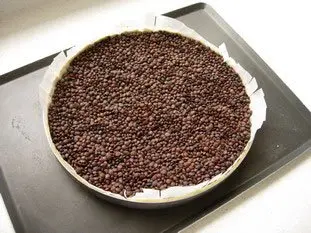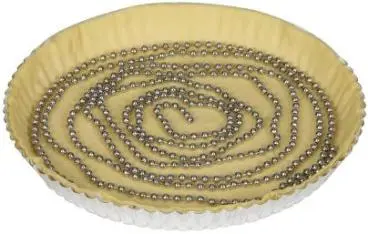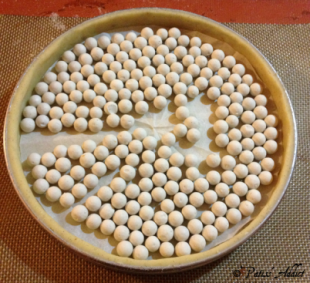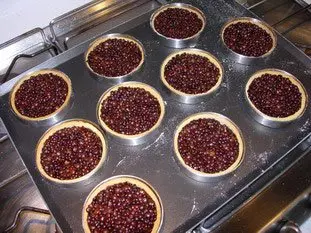This site uses only a few technical cookies necessary for its operation. By continuing to browse, you accept their use.
To find out more...
To find out more...
What can I use for blind baking a pastry case?

When it comes to home-made desserts, tarts are always popular. They can be divided into two basic types: those cooked with their filling, such as an apricot and almond cream tart, and those where the filling is added after baking the pastry case, such as a strawberry tart or chocolate tart.
For tarts where the filling will be added later, we need to cook the pastry case "blind” , as pastry cooks say.
It won't do to simply to line the tart tin with the pastry and bake it empty – the pastry will puff up unevenly in big bubbles which will harden as they cook and the sides are likely to fall in. In short, a disaster. And this is even worse with puff pastry.
To avoid this problem when baking blind, we need to put something in the pastry case to weight it down and keep the base flat, and also hold up the sides. It needs to be easy to remove afterwards, too. Let's take a look at the various possibilities.
For tarts where the filling will be added later, we need to cook the pastry case "blind” , as pastry cooks say.
It won't do to simply to line the tart tin with the pastry and bake it empty – the pastry will puff up unevenly in big bubbles which will harden as they cook and the sides are likely to fall in. In short, a disaster. And this is even worse with puff pastry.
To avoid this problem when baking blind, we need to put something in the pastry case to weight it down and keep the base flat, and also hold up the sides. It needs to be easy to remove afterwards, too. Let's take a look at the various possibilities.
112 K 4.5/5 (25 reviews)
Last modified on: May 2nd 2017
What can I use for blind baking a pastry case?
1) Pie-weight chain

2) Baking beads

3) Dried lentils/beans


Of course, they can be kept and used again and again. I must have been using the same lentils for 25 years!
You will have noticed that I have a preference for lentils, but you should form your own opinion and see what works best for you.
Worth noting, whatever you choose:
- It's a good idea to put a sheet of cooking parchment between the pastry and the lentils or beads. This makes it much easier to remove them after cooking.
- To know when the pastry is done, check the edges: when the top of the pastry crust is nicely browned, the bottom of the case should be cooked.
- After baking, the bottom of the pastry case might well still be very pale, unlike the browned edge. If this bothers you, remove the lentils and paper towards the end of the baking time and leave the pastry to cook uncovered in the top of the oven for a further 5 minutes.
- Always leave a tart case to cool completely before filling, possibly on a wire rack, as this will help the pastry to stay crisp.
To sum up: For blind baking, lentils make the best pie weights. Line the pastry with a sheet of cooking parchment before pouring them in.
Note: When I say that the trick of using dried beans or lentils is as old as the hills, it's because that's how I make my own tarts (maybe you, too). That's how I still see my mother make her tarts now, and how she saw my grandmother do it, and so on…
Lasts posts
Butter vs. grease
We often read in a recipe where a pastry is put into a mould that, just before pouring, the mould should be buttered or greased. But what's the difference between these 2 terms?December 1st 20251,0955
Getting out of the fridge early
Very often when you're cooking, you need to take food or preparations out of the fridge, to use them in the recipe in progress. There's nothing tricky about this: you just take them out of the fridge and use them, usually immediately, in the recipe. But is this really a good method?November 24th 20251,1665
Who's making the croissants?
When you look at a bakery from the outside, you naturally think that in the bakery, the bakers make the bread, and in the laboratory, the pastry chefs make the cakes. It's very often like that, with each of these professions having quite different ways of working, but sometimes there's also one...November 23th 20251,069
Oven height
When we put a dish or cake in the oven, we naturally tend to put it on the middle shelf, and that's what we usually do. But in some cases, this position and height can be a little tricky, so let's find out why.October 8th 20252,8845
The importance of sieving
In recipes that use a fine powder (flour, powdered sugar, etc.), you'll often see the advice to sift before using it. To sift is to pass the powder in question through a sieve (a very fine strainer) before incorporating it into your recipe. It's often advice, but is it really useful?September 3rd 20257,6153
Other pages you may also like
What is the difference between bakery and patisserie?
This is a question that you may well have asked yourself and which I will attempt to answer. In France the two trades of "boulangerie" (bakery) and "pâtisserie" (patisserie and confectionery) have always been quite distinct, but where exactly do the boundaries lie? .February 7th 2017134 K 14.1
The so-called "nervous" meats
You've probably heard this before, we're talking about "nervous" meat, or meat with nerves, to describe what is indicated by the blue arrow on the left. This is a piece of beef, and what we call a nerve is not a nerve, it is in fact collagen (chemists sometimes call it a "collagen sink"), a...April 16th 202137 K4.5
Candied fruits: don't get ripped off
Do you like candied fruit? You might like to nibble a handful or add it to a recipe, like a classic fruit cake or delicious Italian specialities like panettone or sicilian epiphany pie.June 21th 201767 K 24.2
Soup vs. potage
It's true that we're finally coming out of winter as I write these lines, and that we'll all be making, no doubt, a little less soup and potages, but even if it's out of season, it really is a simple and delicious dish, which is one of the always easy answers to "What's for dinner this (Sunday)...April 9th 202211 K
Fruits which can ruin your jelly
There are many ways of making a fruit mousse, but one of the simplest is to prepare a fruit jelly (basically a fresh fruit coulis with gelatine) and then mix this jelly before it sets completely with whipped cream. The result is perfect for filling a charlotte, for example. But do beware;...March 6th 201378 K4.0
Post a comment or question
Follow this page
If you are interested in this page, you can "follow" it, by entering your email address here. You will then receive a notification immediately each time the page is modified or a new comment is added. Please note that you will need to confirm this following.
Note: We'll never share your e-mail address with anyone else.
Alternatively: you can subscribe to the mailing list of cooling-ez.com , you will receive a e-mail for each new recipe published on the site.









